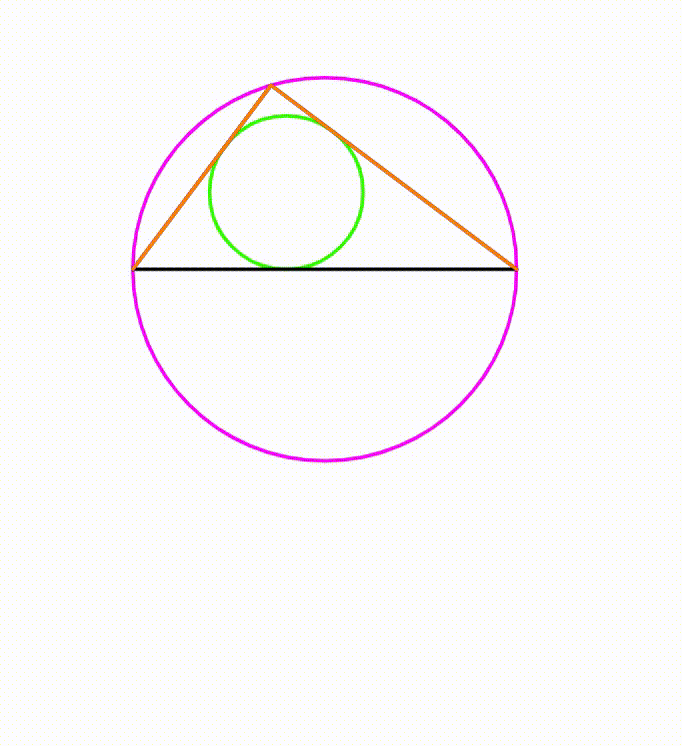Dynamic Geometry: P108
 The diagram shows a blue
-
-
right triangle. An orange triangle is formed using the hypotenuse (black segment), so that the two cyan angles are always equal. When the ratio of its inradius to its circumradius is equal to
, the area of the orange triangle can be expressed as
, where
and
are coprime positive integers. Find
.
The diagram shows a blue
-
-
right triangle. An orange triangle is formed using the hypotenuse (black segment), so that the two cyan angles are always equal. When the ratio of its inradius to its circumradius is equal to
, the area of the orange triangle can be expressed as
, where
and
are coprime positive integers. Find
.
The answer is 2177.
This section requires Javascript.
You are seeing this because something didn't load right. We suggest you, (a) try
refreshing the page, (b) enabling javascript if it is disabled on your browser and,
finally, (c)
loading the
non-javascript version of this page
. We're sorry about the hassle.
Let the variable triangle be A B C , where A B = 5 is the fixed side, and the measure of a cyan angle be θ . The inradius of △ A B C is given by:
r cot 2 A + r cot 2 B r cot ( 2 tan − 1 3 4 − θ ) + r cot ( 2 tan − 1 4 3 − θ ) r ( 2 1 − t 1 + 2 t + 3 1 − t 1 + 3 t ) r ( 1 − 2 t 2 + t + 1 − 3 t 3 + t ) ⟹ r = 5 = 5 = 5 = 5 = 1 − 2 t − t 2 ( 1 − 2 t ) ( 1 − 3 t ) Let t = tan 2 θ
We note that ∠ C = 2 π − 2 θ . Then the circumradius of △ A B C is given by:
2 R ⟹ R = sin C 5 = sin ( 2 π − 2 θ ) 5 = cos 2 θ 5 = 4 ( 1 + t 2 1 − t 2 ) 2 − 2 5 = 2 ( 1 − 6 t 2 + t 4 ) 5 ( 1 + t 2 ) 2
When R r = 6 2 5 1 2 4 , then
( 1 − 2 t − t 2 ) ( 1 + t 2 ) 2 ( 1 − 2 t ) ( 1 − 3 t ) ( 1 − 6 t 2 + t 4 ) ( 1 + t 2 ) 2 ( 1 − 2 t ) ( 1 − 3 t ) ( 1 + 2 t − t 2 ) 8 1 2 t 4 − 2 1 2 5 t 3 + 7 4 9 t 2 + 3 7 5 t − 6 3 ( 4 t − 3 ) ( 7 t − 1 ) ( 2 9 t 2 − 5 0 t − 2 1 ) ⟹ t ⟹ θ = 1 2 5 6 2 = 1 2 5 6 2 = 0 = 0 = 7 1 = tan − 1 1 − 4 9 1 7 2 = 2 4 7 For θ < tan − 1 4 3
The area of △ A B C :
[ A B C ] = 2 1 A B ⋅ C A sin A = 2 sin C A B 2 ⋅ sin A sin B = 2 sin ( 2 π − 2 θ ) 2 5 sin ( tan − 1 3 4 − θ ) sin ( tan − 1 4 3 − θ ) = 2 ( 6 2 5 5 7 6 − 6 2 5 4 9 ) 2 5 ( 5 4 ⋅ 2 5 2 4 − 5 3 ⋅ 2 5 7 ) ( 5 3 ⋅ 2 5 2 4 − 5 4 ⋅ 2 5 7 ) = 2 ⋅ 5 2 7 7 5 ⋅ 4 4 = 5 2 7 1 6 5 0 By cosine rule Note that sin ( 2 π − ϕ ) = cos ϕ
Therefore p + q = 1 6 5 0 + 5 2 7 = 2 1 7 7 .